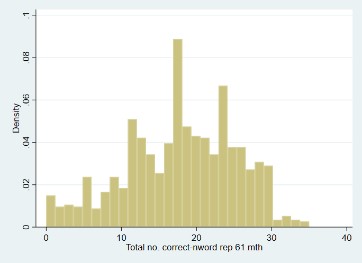The Avon Longitudinal Study of Parents and Children (ALSPAC) assessed their cohort members (CMs) at 61 months’ age (Children in Focus Clinic) using a measure of Short-term Memory (Nonword Repetition).
Details on this measure and the data collected from the CMs are outlined in the table below.
| Year of data collection: | 1997-1998 |
| Domain: | Verbal memory |
| Measures: | Short-term memory |
| Memory Span | |
| CHC: | Gsm (Short-term memory) |
| CLOSER Source: | Explore this sweep in CLOSER Discovery: ALSPAC Childhood (5 years to 12 years 11 months) (opens in a new tab) |
| Administration method: | Trained interviewer; clinical setting; questions answered orally |
| Procedure: | The child was presented with 40 nonwords (10 each containing 2, 3, 4 and 5 syllables) played on an audio cassette recorder. The child was asked to repeat each item after it was played. The number of correctly repeated words at each syllable length was recorded. |
| Link to questionnaire: | http://www.bristol.ac.uk/alspac/researchers/our-data/clinical-measures/ (opens in new tab) |
| Scoring: | Number of correct 2 - 5 syllable words (0 - 10) |
| Total number of correct words (0 - 40) | |
| Item-level variable(s): | cf470 - cf476 |
| Total score/derived variable(s): | cf475 |
| Descriptives: | N = 943 |
| Range = 0 - 35 | |
| Mean = 17.91 | |
| SD = 7.33 | |
(click image to enlarge) |
|
| Age of participants (months): | Mean = 67.19, SD = 0.8, Range = 65 - 73 |
| Other sweep and/or cohort: | ALSPAC – Age 8.5 – Short Term Memory (Non-word Repetition) |
| Source: | Gathercole, S. E., & Baddeley, A. D. (1996). The children's test of nonword repetition. Pearson. |
| Technical resources: | None |
| Example articles: | Gathercole, S. E., Tiffany, C., Briscoe, J., Thorn, A., & ALSPAC team. (2005). Developmental consequences of poor phonological short-term memory function in childhood: A longitudinal study. Journal of Child Psychology and Psychiatry, 46(6), 598-611. |
| Gathercole, S. E., Briscoe, J., Thorn, A., Tiffany, C., & ALSPAC Study Team. (2008). Deficits in verbal long-term memory and learning in children with poor phonological short-term memory skills. The Quarterly Journal of Experimental Psychology, 61(3), 474-490. |
For the named items in the table above, links are provided to their corresponding content on CLOSER Discovery. Where a variable range is provided, full variable lists can be accessed through the ‘Variable Groups’ tab on the linked Discovery page.
Go to:
- Overview of all cognitive measures in ALSPAC
- Overview of childhood cognitive measures across all studies
This page is part of CLOSER’s ‘A guide to the cognitive measures in five British birth cohort studies’.
